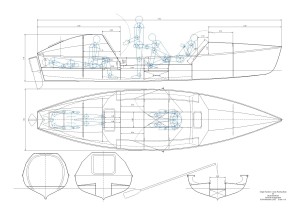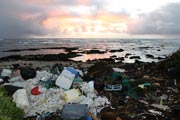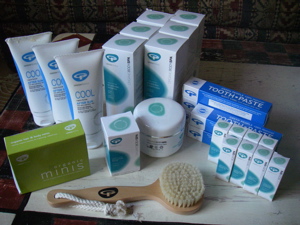
Last summer my boat was nearly rescued by Steve Fossett's yacht, the Cheyenne. Now the Cheyenne's crew may be coming to my rescue in a rather different way...
Last year's Pacific bid ended prematurely due to large waves and the loss of my sea anchor causing my boat to capsize. It seemed to me at the time that the waves were no larger than anything that I had encountered on the Atlantic, so it seemed likely that the cause of my problems was all the extra bits and pieces that had accumulated on the roof of my cabins - aerials, antennae, weather stations, and a considerably heavier pair of spare oars. (After all 4 of my oars broke on the Atlantic, I had opted for solid ash oars rather than hollow tubes of carbon fibre.) None of these items were a major weight in themselves, but the cumulative total was apparently enough to shift the centre of gravity upwards - leading to capsize.
So I've been talking with Nancy from the Cheyenne, a dab hand in glass fibre work, who is on standby to do the work as soon as we have finalized the specification.
And I've been on the phone to Devon in England talking to Phil Morrison, the original designer of the hull, to ask his advice on how much weight might be needed, and where it should be distributed. It has been invaluable finding out more about the why and the wherefore of the hull design. For example, I learned that the intention is that when a big wave broadsides the boat, rather than the hull 'digging in' to the water and the boat tipping over, the hull is designed to skid sideways across the water, while the boat remains upright - provided, of course, that the centre of gravity is in the right place.
At first I thought we were going to have to add a kind of false bottom to the boat - laying a lead pipe (or similar) along the central ridge that runs the length of the hull, and then glassing it in. But then it occurred to me that several of the hatches along the centre line have flat bottoms, so there is presumably an empty air space between the hatch floors and the hull - so now we are exploring the possibility of creating access to these areas via the hatches and inserting ballast from above. This would be much simpler - and hence cheaper.
I have just 3 months now before I go on standby to depart. Rick Shema, my weather guy, tells me that this is an El Nina year. Although the effects of La Nina will be diminishing by summer, it could still cause higher-than-average winds, and hence waves. So if I am to avoid a repeat of last year's washing machine simulation, a rebalancing of the boat is top priority.
|
|

This article in today's New York Times asks when governments and global organizations are going to step in and save the oceans. It's a valid question, and undoubtedly more should be happening at the highest levels.
But governments and large organizations move slowly, and change direction even more slowly. In the meantime the oceans are deteriorating day by day.
Individuals and small organizations can respond much more quickly - taking immediate action by voting through our everyday actions, like saying No to plastic bags and disposable items, and making sure that we eat only fish from non-threatened species.
Grassroots actions can also create pressure upwards to show governments that we care what kind of a world we live in.
So although governments DO need to act, let's not sit on our hands and wait while the oceans die...
Here is an example of what people are doing to take action: when I was in Hawaii I met the staff of BEACH - Beach Environmental Awareness Campaign Hawaii. There are only two of them, but look what they are doing!
Now, even if you don't have time, or live too far away, to help clean a beach - who can honestly say that they don't have time to pick up a piece of litter when they see it in the street, and put it in the nearest bin? That piece of litter could otherwise end up in the drains, washing into a river, flowing to the sea... and choking an albatross. You never know the good you might do. I like to think of it as the Ripple Effect...
[photo: not what we imagine a Hawaii beach to look like]
|
|
"Hydrate or Die" - so it says on the side of my Camelbak water bottle. But recently I've been exploring the virtues of dehydrating - but this is fine and healthy, because I'm dehydrating my food, not myself.
I've spent the last two afternoons in the company of a new friend, Eva, who was introduced to me via a regular visitor to my website, Maui Bob, aka LJ Silver. I have to confess that my dehydrator had arrived over a month ago, before I left for New Zealand, but had sat in its cardboard box in a corner ever since. I would glance at it occasionally and wonder what the hell I was supposed to do with it.
Fortunately, Eva came to the rescue, and the mysterious box is now unpacked, and the dehydrator is whirring away busily in my kitchen. Over the last couple of days we have made granola, falafel, tamari sunflower snacks, nori crackers and flax crackers.
But why bother? you may be wondering. What does a dehydrator do that ordinary cooking doesn't?
Two reasons:
1. With the dehydrator I can create my own healthy meals for my rowing trip, rather than relying on expensive, low-grade, highly processed pre-packaged expedition foods.
2. Even while I am on dry land, the dehydrator opens up a whole realm of healthy new food options.
This is my understanding: before ingredients such as nuts, sunflower seeds, buckwheat and flax are incorporated into recipes, they are soaked overnight. This brings them to life, activating the enzymes that would eventually lead them to grow into sprouts and then plants. So instead of the nut being "dead" food, it is now alive.
Then, once you've mixed the live nuts or grains with all kinds of interesting ingredients and flavourings, the dehydrator "cooks" them into cookies/burgers/crackers at such a low temperature (110 degrees F) that the enzymes stay alive - compared with ordinary cooking which would kill them.
So the end product has all these health-giving enzymes that allow the body to digest the food more fully, gaining optimum nutrition from it.
More importantly as far as I am concerned, the end results are absolutely delicious. I am a sworn carnivore, but with veggie food like this, I could almost give up meat and not miss it. Uh oh - maybe I'm on my way to being a fully-fledged granola-head!
Here is my favourite recipe so far, although do get in touch if you have any other suggestions you would like to share.
And a P.S. One of the great things about the dehydrator is that I can incorporate the by-product from my juicer - the pulp from fruit and vegetables - into crackers, veggie "leathers", etc. So nothing goes to waste!
"Sunshine" burgers
1C walnuts, soaked overnight
1C pumpkin seeds, soaked overnight
7 sundried tomato halves, soaked for 4 hours (and save the liquid)
2/3 C mushroom stems and/or tops
2T Nama Shoyu sauce (a healthy form of soy sauce)
¼ t salt
1/3 C grated carrots
1t chilli powder
1t parsley
½ t garlic
3T olive oil
Combine in a food blender. Shape into patties. Dry in the dehydrator for as long as it takes - probably 12-16 hours.
|
|

No, not me. I wish! It's the title of Green People, sponsors of my skincare products and all-important sun protection.
The book includes many tips for natural body care, and also this startling statistic:
The average woman uses 15 personal care products a day. Up to 60% of the chemicals you put on your skin can end up in your bloodstream so you could be absorbing as much as 2kg (4.4lb) of man-made chemicals every year.
That's why I like using Green People's all-organic products. There is no point spending extra money to buy organic fruit, vegetables and meat if I then undo the good work by rubbing toxins into my skin. Especially given the large quantities of sun cream that I will need to use during my Pacific crossing, I want to know that I am not slowly poisoning myself!
It's refreshing to find a company that does not stint on the quality of their ingredients. At the risk of mentioning a possible competitor to Green People, I have just finished reading Body and Soul: Profits with Principles by Anita Roddick, the amazing and inspirational founder of The Body Shop. She saw her business as a way of effecting environmental, ethical and cultural change, inseparable from her own personal values. Shop windows became showcases for the issues that concerned her, and through their campaigns The Body Shop raised awareness and money for all kinds of good causes. Until her death in September last year she was a true pioneer of a different way of doing business - and the profitability of The Body Shop shows that this business paradigm actually works.
The book left me very inspired. It may not be the best-written, but she is passionate and persuasive and really made me believe that strong principles and a successful business are entirely compatible - as also demonstrated by Charlotte Vohtz and Green People. Recommended.
|
|